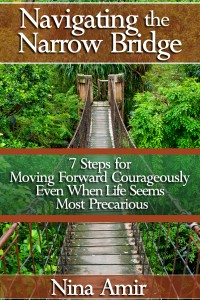Do you worry that you will lose your job and then your home or your life’s savings? Do you feel anxious about the possibility that you could be diagnosed with cancer or have a serious car accident? Or do you feel afraid that you can’t make your business or relationship work—that you’ll fail or end up alone?
Worry and anxiety turn into fear, and fear becomes terror. And you freeze. You can’t move.
Any degree of fear stops you from reaching your full human potential. It keep you stuck in place, unable to move forward to achieve your goals. Plus, your fearful thoughts create additional reasons to feel fear.
However, learning to move through your fear, or to deal with it in a positive manner, allows you to achieve a new level of personal growth. It frees you to move forward again. In this way, you can, indeed, live your life fully.
How to Remove Your Fear
Look differently at the things you fear. A new perspective removes fear from your life or, at least, lessens its impact.
Terror and awe represent opposite extremes of the same spectrum. To reduce your worry and anxiety, feel awe for what you fear. Experience the situation or condition as awe-inspiring rather than fear-inspiring.
The Fear Spectrum
In Hebrew, the word for awe, fear and terror are the same—yirah. The reason for this comes from the fact that they exist in different places on the same spectrum of emotion. To understand this spectrum and how it might help reduce fear, consider the definitions of terror and awe.
Terror constitutes intense fear or anxiety. That is not worry but full-blown, overriding fear.
Awe, on the other hand, is an overwhelming feeling of reverence or admiration or the power to inspire these feelings. It also includes fear or the power to inspire fear. So, for example, you can feel awe or fear of God.
The Edge of the Cliff
Imagine yourself feeling awe at arriving at the top of a mountain and seeing the gorgeous panoramic view. Lovely, right?
Now imagine yourself moving closer to the edge of the cliff and feeling fear.
See yourself moving even closer to the cliff’s edge, so close that your toes almost hang over. See little rocks tumble off the edge from under and around your feet. Feel the terror that fills your body as you consider the possibility of falling.
Take a Step (or Two) Back to Awe
If you can imagine yourself physically step backward from terror to fear and then backward again to awe, you see the miracle of life once again. You feel wonder and exhilaration at the miracles around you; you feel awe for God’s presence in all that exists.
That’s how you experience both ends of the emotional spectrum of fear—terror and awe.
Change Your Focus
Simply changing your focus accomplishes this movement on the spectrum as well. Imagine yourself still standing at the edge of the cliff. Where is your attention focused? It is on the rocks tumbling off the edge and down to the ground far below and on the possibility that your body will follow them. That’s a choice.
Indeed, you can decide to focus on the dirt and rocks falling and your toes at the edge of the solid ground. This inevitably will bring up your feelings of being vulnerable and exposed to danger. But you can make a different choice.
 You can decide to focus on the same thing you focused on as you came up the trail—the fabulous, awe-inspiring spectacle of nature and God’s handiwork. Instead of fear, you would feel awe.
You can decide to focus on the same thing you focused on as you came up the trail—the fabulous, awe-inspiring spectacle of nature and God’s handiwork. Instead of fear, you would feel awe.
In this way you return to awe not by physically stepping backward and away from that which causes you fear or terror. You simply back up your thoughts and emotions to the place where you felt awe, to the place where you experienced the thrill of life. You change your emotions by changing your thoughts and where you place the focus of your attention.
Or you can put your attention on the fact that you are standing at the edge of a cliff. Be in the moment. Allow yourself to feel the exhilaration of standing on the edge of a cliff and knowing all is well. Allow yourself to see the miracle in that moment, in the fact that you are safe. Make a choice about how you will feel in the moment, how you will perceive the experience. Be in the “now.”
Walk Across the Bridge
You also can picture awe and fear as existing on opposite ends of a bridge. Find a way to walk across the bridge from one end to the other. Find a place along the bridge that feels positive and comfortable. Eventually, you will end up at the opposite end of the spectrum. In other words, if previously you stood on the “fear side” of the bridge, you now stand at the “awe side.”
Any other thoughts or feelings that go with your sense of fear can be used in this exercise. For instance, you can walk from the “fear side” to the “courage side” or “safety side.” If you felt “insecure” before, you may now stand on the side of “security.”
To accomplish this, take small steps—actual actions—that help your traverse the mental bridge as well as physically move through your fear. Also do this by making choices about where you focus. Decide if you will place your attention on fear or awe.
If you remain conscious and aware, you can choose fear or awe at any moment. By so doing, you dictate if you are able to move forward freely and courageously towards your goals or if fear will keep you stuck in place. If you are daring, you will live your life more fully and achieve your human potential.
If you want to read more about moving through fear, read my ebook, Navigating the Narrow Bridge: 7 Steps for Moving Forward Courageously Even When Life Seems Most Precarious.
Photo courtesy of pressmaster|stockfresh.com.



